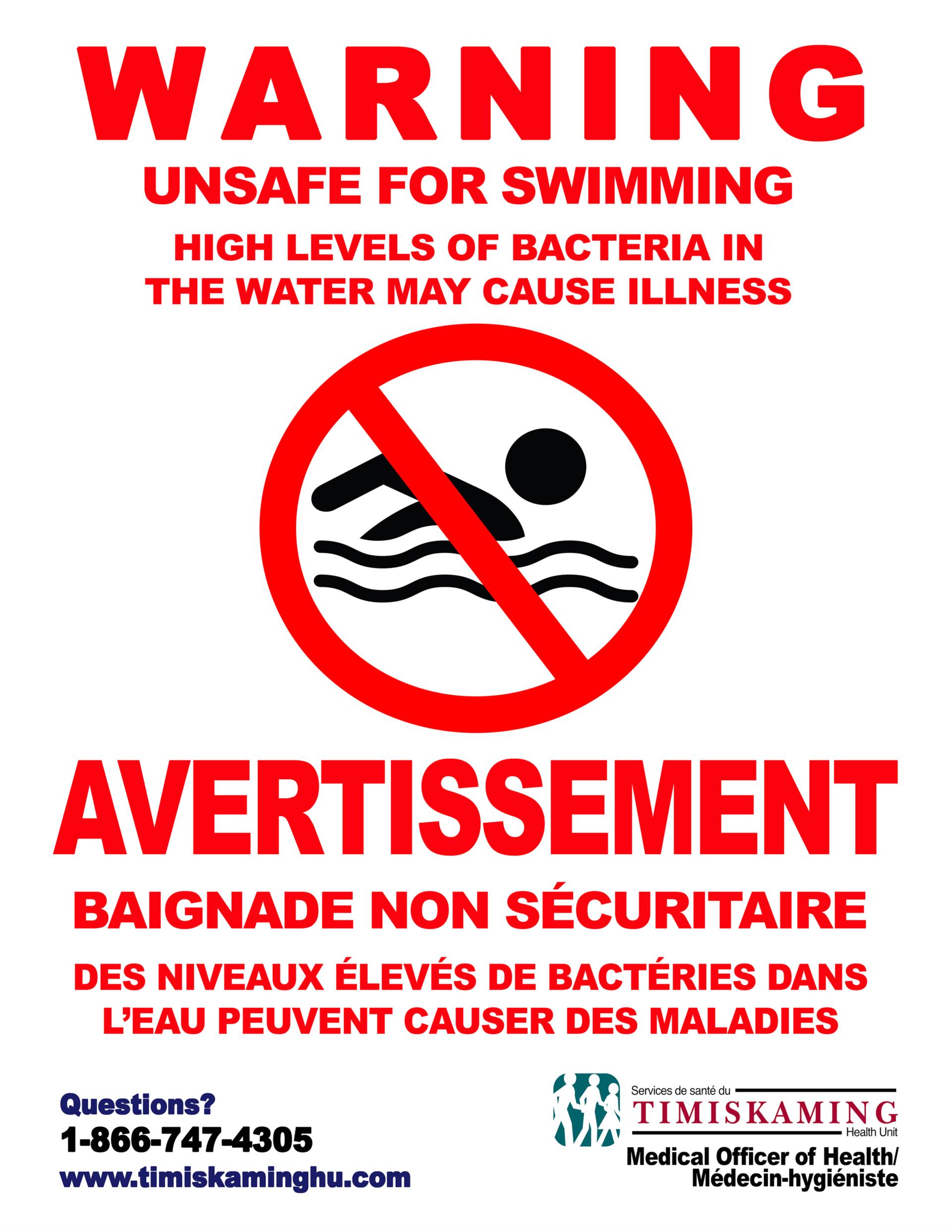Recreational Water Testing Program
The Timiskaming Health Unit (THU) is responsible for monitoring the beach water quality within the district and has a role in identifying factors that have an impact on beach water quality. Each year, a survey is conducted at all public access bathing beaches in the area where potential sources of pollution are identified. Routine water sampling begins in June and continues through the bathing season to the Labour Day weekend in September. Water samples are taken weekly from New Liskeard Beach and monthly from all other public bathing beaches within the health unit and are tested for bacteria levels. These samples are collected according to the Ontario Ministry of Health and Long Term Care Recreational Water Protocol, 2018.
 When results from bacteria sampling indicate that bacteria levels exceed provincial guidelines, an advisory warning sign is posted at the bathing beach to let you know the water may not be suitable for swimming. Timiskaming Health Unit staff will post advisory warning signs in visible locations at the public bathing beach to alert swimmers of the potential risk. These signs will be removed once additional sampling indicates that bacteria levels at the public bathing beach have returned to acceptable levels.
When results from bacteria sampling indicate that bacteria levels exceed provincial guidelines, an advisory warning sign is posted at the bathing beach to let you know the water may not be suitable for swimming. Timiskaming Health Unit staff will post advisory warning signs in visible locations at the public bathing beach to alert swimmers of the potential risk. These signs will be removed once additional sampling indicates that bacteria levels at the public bathing beach have returned to acceptable levels.
This table provides a summary of the public bathing beaches in the Timiskaming district, their current sampling frequency and status.
|
Name of Beach
|
Status
Updated:
2023-08-14
|
Sampling Frequency
|
|
Bass Lake
|
Open
|
Monthy
|
|
Bucke Park
|
Open
|
Monthly
|
|
Charlton
|
Open
|
Monthly
|
|
Crystal Beach
|
Open
|
Monthly
|
|
Culver Park Beach
|
Open
|
Monthly
|
|
Elk Lake Beach
|
Open
|
Monthly
|
|
Gowganda Beach
|
Open
|
Monthly
|
|
Haileybury
|
Open
|
Monthly
|
|
Larder Lake Beach
|
Open
|
Monthly
|
|
Latchford Beach
|
Open
|
Monthly
|
|
Loon Lake |
Open
|
Monthly
|
|
Matachewan Beach
|
Open
|
Monthly
|
|
New Liskeard
|
Open
|
Monthly
|
|
Pike Lake |
Open
|
Monthly
|
|
Raven Park Beach
|
Open
|
Monthly
|
|
Temagami North
|
Open
|
Monthly
|
|
Temagami Public Beach
|
Open
|
Monthly
|
What are Public Bathing Beaches?
- Don't use soap in the water. Soap nourishes algae and bacteria, helping them to grow.
- Avoid attracting animals and birds by limiting the amount of food taken to the beach. Don't feed animals or birds, and securely close garbage bins.
- Stoop and scoop after your pet.
- Avoid using fertilizers near beach water.
- Practice pollution-free boating and dispose of human waste hygienically.
What about Provincial Parks?
Provincial Park beaches are monitored by the Ministry of Natural Resources and beach water quality at parks can be viewed here.
If you have concerns regarding the bacteriological quality of a public bathing beach, please contact our office and we will investigate.
If you are aware of a potential blue green algae bloom, please notify the Ontario Ministry of the Environment, Conservation and Parks at the Spills Action Center number: 1-866-663-8477.
Frequently Asked Questions
Q: How are water samples collected?
A minimum of five water samples are taken per beach. The samples taken are approximately 200 metre apart at a depth of 15-30 cm below the water surface where the water is 1-1.5 metre deep.
Q: What are water samples tested for?
Water samples are analyzed for Escherchia coli (E.coli). E. coli bacteria are an indicator of fecal contamination from human and animal sources. The presence of E.coli indicates that other harmful micro-organisms, such as bacteria, viruses, and parasites may also be present.
Q: When is a beach considered unsafe for swimming?
A beach is considered not safe for swimming when an average of greater than 100 E.coli bacteria per 100 mL water were present in the latest samples. Illness can occur if surface water contaminated with E.coli is swallowed, enters ears, eyes, or nose, or comes in contact with open wounds.
Q: How will we know if a beach is unsafe for swimming?
The municipality will be notified of the results and the following notice will be displayed in prominent positions at the beach indicating the nature of the risk. You can also consult the THU website.
20230814/cc:nd